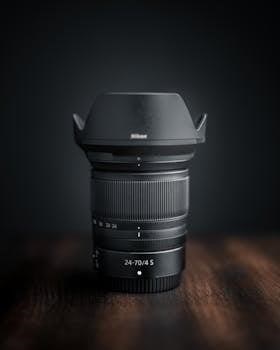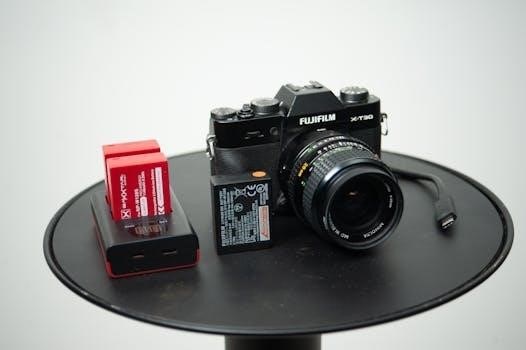Nikon D3100 Overview
The Nikon D3100, a popular DSLR, was released in 2010. It’s often compared to models like the Canon 1200D, 1100D, and 600D. This camera offers various options for users seeking a balance between functionality and ease of use.
Release Year and Model
The Nikon D3100, a digital single-lens reflex camera, entered the market in 2010, marking its place as an entry-level option within Nikon’s extensive lineup. This model is specifically designed for those transitioning from point-and-shoot cameras or newcomers to the world of DSLR photography. Its features are tailored to offer a user-friendly experience while still providing the flexibility and image quality that DSLRs are known for. The D3100 quickly became a popular choice for beginners due to its intuitive interface, guided shooting modes, and the ability to capture high-resolution images and full HD videos. This camera’s release signifies Nikon’s commitment to making advanced photography accessible to a broader audience, ensuring that even novice users can produce impressive results. The D3100’s market impact is further evidenced by its frequent comparisons to competitor models, such as Canon’s 1200D, 1100D and 600D, which were released around the same period. This model represents a significant step forward for amateur photographers seeking to explore the capabilities of a DSLR.

Comparison with Similar Models
When considering the Nikon D3100, it’s essential to look at how it stacks up against similar models from its time. The Canon 1200D, 1100D, and 600D are often cited as direct competitors, as they occupy a similar space in the entry-level DSLR market. Each of these cameras offers a slightly different set of features and capabilities, which can sway a user’s decision depending on their specific needs. The Nikon D3100, for example, is noted for its user-friendly interface and guided shooting modes, making it particularly appealing to beginners. On the other hand, Canon models such as the 600D might offer more advanced features. Comparisons often highlight differences in sensor technology, image processing capabilities, and video recording options. While the D3100 excels in certain areas, like its ease of use, other cameras may have an edge in terms of available advanced settings or video quality. Therefore, prospective buyers should carefully weigh their individual priorities and preferences when comparing these models to select the best fit.

Nikon D3100 Manual
The official Nikon D3100 manual is a crucial resource for understanding the camera’s functions. It is available as a PDF document for download, providing detailed instructions on various aspects of the camera.
Official PDF Manual Download
The official Nikon D3100 PDF manual is readily available for download, providing a comprehensive guide to the camera’s features and operations. This manual, typically hundreds of pages long, serves as an essential reference for both new and experienced users. It covers everything from basic camera setup to advanced shooting techniques. The PDF format allows users to easily search for specific topics and access the information they need quickly. This is particularly helpful when troubleshooting or attempting to understand a less familiar function. The manual is often provided by Nikon directly and is the most reliable source of information. It includes detailed explanations of all menu options, settings, and modes available on the D3100. Users can download it to their computers, smartphones, or tablets for convenient access. Remember that the manual is designed to be used in conjunction with hands-on experience with the camera itself. The PDF format also allows for easy printing of specific pages if needed, making it a versatile resource for learning and mastering the Nikon D3100.
Language Options in Manual
The Nikon D3100 manual typically offers multiple language options to cater to a global user base. This ensures that users can access the information they need in their preferred language, improving comprehension and ease of use. The availability of various languages is crucial for users who may not be fluent in English. Having the manual in one’s native language allows for a more thorough and confident understanding of the camera’s functionalities. Language options usually include major languages such as Spanish, French, German, and others, in addition to English. The manual may also provide instructions on how to change the language displayed on the camera’s menu system, which is a separate but related function. This allows users to navigate the camera’s settings in their language, making it easier to customize the camera to their needs. The language selection in both the manual and the camera’s menu is designed to be user-friendly and straightforward, allowing for simple language switching, enhancing the overall user experience, and ensuring that the camera is accessible to everyone regardless of their language background. The official manual is the best place to confirm which language options are available.

Nikon D3100 Camera Settings
The Nikon D3100 provides users with various settings to customize their photography experience. Adjustments can be made through the information screen and the menu system, offering flexibility in capturing different scenes and effects.
Adjusting Settings on Information Screen
The Nikon D3100’s information screen serves as a central hub for quickly modifying key camera settings. Users can access and adjust various parameters directly from this display, streamlining the shooting process. This feature is particularly useful for photographers who need to make rapid changes to their settings without navigating through the full menu system.
Key adjustments available on the information screen include ISO sensitivity, white balance, image quality, and shooting mode. The screen also displays information such as aperture, shutter speed, and exposure compensation, allowing photographers to monitor their settings effectively. By leveraging the information screen, users can quickly optimize the camera for different lighting conditions and creative objectives. This intuitive interface enhances the user experience, especially for those who prefer a more hands-on approach to photography, allowing for efficient and precise adjustments to capture the desired image.
Furthermore, the information screen provides real-time feedback, enabling photographers to make informed decisions about their settings and ultimately improve the quality of their photographs. The ability to swiftly change settings on the information screen is a significant advantage, particularly in dynamic environments where conditions change rapidly.
Navigating the Menu System
The Nikon D3100’s menu system is designed to provide access to a comprehensive range of camera settings and features. Understanding how to navigate this system is crucial for unlocking the full potential of the camera. The menu is organized into logical categories, allowing users to efficiently find the options they need. Familiarizing oneself with this layout is essential for making precise adjustments and tailoring the camera to individual shooting styles.
Users can access the menu by pressing the ‘MENU’ button on the camera body. The menu system includes options for image quality, shooting settings, playback options, and various setup parameters. Each section is further subdivided, allowing for granular control over different aspects of the camera. The ability to navigate the menu effectively empowers users to personalize their photography and achieve their creative goals. The menu system also provides access to more advanced functions, such as custom white balance and picture control settings, offering a high degree of flexibility and control over the final image. Furthermore, the menu system facilitates the setup of the camera, enabling users to configure it to their preferences.
The structured layout of the menu and the clear presentation of options aid photographers in mastering the camera’s capabilities, thereby enhancing their overall shooting experience.

Nikon D3100 Additional Resources
For further assistance, resources such as the Nikon Viewer 2 guide can be helpful. These tools can enhance your understanding of the camera’s capabilities and improve your photography skills.
Nikon Viewer 2 Guide
The Nikon Viewer 2 software is a valuable tool that complements the Nikon D3100, providing users with a range of options for managing and enhancing their digital photos. This guide focuses on using Nikon Viewer 2 to streamline your workflow and achieve optimal results. The software allows you to import images directly from your camera to your computer. After importing, you can utilize various features such as image browsing, editing, and file management. This guide also covers how to install the Nikon Viewer 2 application on your smartphone or tablet for easy viewing and transfer of photos.
Furthermore, you can learn how to efficiently organize your images with the software’s tagging and cataloging features. Nikon Viewer 2 also provides basic editing tools, allowing users to adjust brightness, contrast, and color balance. It is essential to explore the program to fully leverage its capabilities. Understanding how to use Nikon Viewer 2 will significantly enhance your post-processing workflow. This guide ensures that users can easily navigate the software, making image management more efficient and enjoyable. Additionally, you will find resources on troubleshooting common issues that may arise when using the software.
Using Control Dials
The Nikon D3100 features control dials that are essential for making quick adjustments to camera settings. Understanding how to use these dials is crucial for taking full advantage of the camera’s manual and semi-automatic modes. The primary control dial, typically located near the shutter button, is used to change settings such as aperture and shutter speed. In manual mode, rotating this dial will directly alter the selected setting, allowing for precise control over exposure. In aperture-priority or shutter-priority modes, the dial will adjust the respective setting while the camera automatically adjusts the other to maintain proper exposure.
Additionally, many of the menus and setting adjustments are navigated using the control dial, meaning familiarity with its operation will improve the speed and ease of making changes. The control dial is also used to scroll through images in playback mode, making it a versatile tool. For example, when reviewing photos, the dial can help you quickly navigate through pictures. Learning to use the control dials efficiently is a foundational skill for any user of the Nikon D3100. This understanding will significantly enhance your ability to capture the images you envision.

